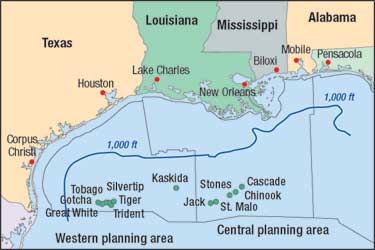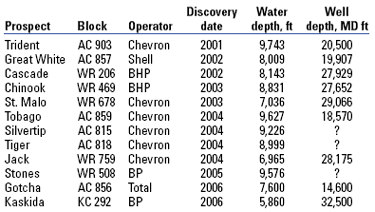What's new in exploration
Lower Tertiary play in the GOM; Maybe the Cambrian Explosion didn't explode.
Lower Tertiary play. The US MMS released a summary of Lower Tertiary discoveries in the ultra-deep waters of the Gulf of Mexico. Lower Tertiary formations were deposited from about 65 million to about 35 to 23 million years ago. These discoveries vary in depth from 15,000 ft to 30,000 ft. "This trend," noted MMS Director Johnnie Burton, "could be as wide as 300 mi and involve as many as 3,000 blocks that MMS administers." Until these recent announcements, the reserve contribution of the Lower Tertiary in the Gulf was negligible. Ninety-nine percent of the GOM proved reserves were found in Miocene age (Upper Tertiary) sediments less than 23 million years old and younger, while 1% were in Jurassic and Cretaceous age sediments, 65 million years and older, which are primarily in nearshore areas off Louisiana and Alabama. MMS officials also noted that widespread industry interest in the Jack 2 well test and BP's Kaskida prospect preceded heavy bidding at MMS's Western Gulf Sale 200 in August. At that sale, 82 tracts received bids in the Keathley Canyon area. In addition, the highest bid at the sale was BP's $21 million for Block 58 in Keathley Canyon, Petrobras' bid of $12.8 million for neighboring Block 59, and Shell's bid of $6.0 million for Block 56. Way before the Burgess. We've all been schooled in the so-called Cambrian Explosion, made famous when it was restricted to the Burgess Shale of British Columbia. If you've kept up, you've probably been aware of the debate as to whether the "explosion" part is a bit of a misnomer. However, the concept of general rapidity of evolutionary forms during the Cambrian has not become unseated, but it is getting increasingly stretched out in time. It remains an unsettled area of ongoing research and great controversy. In the June 16 and October 13 issues of Science, evidence is presented that fossilized embryos, predating the Explosion by at least 10 million years, provide evidence that early animals had already begun to adopt some of the structures and processes seen in modern embryos.
James Hagadorn of Amherst College led a multi-disciplinary international team from the US, UK, China, Sweden, Switzerland and Australia. This is the first direct evidence that primitive animals of Precambrian (550 million years ago) age were capable of asynchronous cell division during embryonic development. This is a necessary precursor for the formation of the unique shapes found in the Explosion. The researchers also believe they identified specialized structures inside the cells, such as bubble-like vesicles that the cells might have used to transport, store or metabolize molecules. Slight aberrations during the fossilization of dead embryonic cells even reveal what appear to be dividing nuclei. It was assumed such structures existed in early animals, but until now, no known fossils of the structures existed. The scientists procured 162 "relatively pristine" animal embryo fossils from the Doushantuo Formation of south-central China. The embryos were still encased in a fertilization envelope, a protective husk that likely aided the preservation of the embryos long enough for fossilization to occur. To inspect the fossils' surfaces and even innards, the scientists used a bevy of imaging techniques, including X-ray computed tomography, scanning electron microscopy, transmission electron microscopy and thin-section petrography. Although there appear to be millions of exceptional embryonic and larval fossils in the Doushantuo Formation, oddly, there are as yet no adult forms. This could be because there are no adults, or because there is some sort of geologic filtering mechanism that eliminates adult fossils; neither explanation makes much sense. Intact fossil embryos are extremely rare. The Doushantuo Formation has proved a boon to paleontologists and evolutionary developmental biologists researching the evolution of animal species during and prior to the Cambrian Explosion. CSEM patent fight. The UK patent dispute between emgs and OHM is back on again. A press release from emgs in early October said that "Electromagnetic Geoservices AS (emgs) has launched proceedings in the High Court in London against Offshore Hydrocarbon Mapping plc (OHM) for the infringement of one of emgs patents related to Seabed Logging, also referred to as controlled source electromagnetic (CSEM)." Earlier this year, The University of Southampton, which claims certain intellectual rights that are used by OHM, withdrew an appeal against a decision made in July 2005 by The UK Patent Office. The Patent Office had concluded that the inventive concept in the Seabed Logging patent was devised by Terje Eidesmo and Svein Ellingsrud (now at emgs) and belonged to Statoil (now transferred to emgs).
|
|||||||||||||||||||||||||
- Prices and governmental policies combine to stymie Canadian upstream growth (February 2024)
- U.S. producing gas wells increase despite low prices (February 2024)
- U.S. drilling: More of the same expected (February 2024)
- U.S. oil and natural gas production hits record highs (February 2024)
- Quantum computing and subsurface prediction (January 2024)
- U.S. upstream muddles along, with an eye toward 2024 (September 2023)






